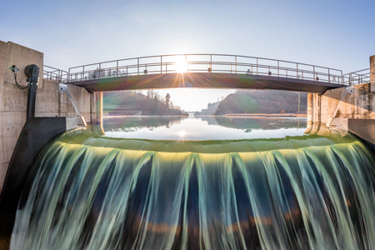The Future Of Hydroelectric Power: Balancing Generation With Environmental Impact
By Ellie Gabel

Hydropower remains fundamental to renewable energy production because it offers steady output and grid reliability in a world racing to decarbonize. However, as global climate goals become more ambitious, the environmental impact of hydroelectric systems — especially on river ecosystems, fish migration and sediment flow — draws increased attention.
Energy leaders and water resource professionals are now challenged to rethink how hydro projects can balance power generation with ecological responsibility. The conversation has shifted from expansion to optimization, where smarter infrastructure and adaptive strategies must work together to reduce harm without compromising output.
Scaling Efficiency Without Scaling Harm
Modern hydroelectric power is evolving to address long-standing ecological concerns without sacrificing performance. Traditional dams often obstruct fish migration routes and alter natural water temperatures, which disrupts aquatic ecosystems and reproduction cycles. To counter this, engineers introduce fish-friendly turbines and low–head designs that allow safer passage and reduce injury or mortality. These innovations are especially valuable in retrofitting older facilities, where structural changes can be costly or impractical.
At the same time, hydro operators leverage real-time data and predictive modeling to fine-tune water flow, ensuring enough discharge for energy production while protecting downstream habitats. Upgrades to legacy plants, including digital controls, new turbine blades and environmental bypass systems, prove that it’s possible to boost efficiency and reliability without building new reservoirs.
Climate Volatility And Adaptive Water Management
As climate patterns shift, hydroelectric facilities are under growing pressure to adapt to unpredictable water availability and extreme weather events. Changes in snowpack, longer drought cycles and erratic rainfall impact how reservoirs are managed and how reliably they can generate power.
These challenges have pushed operators to adopt more adaptive release strategies that carefully balance peak electricity demand with the ecological needs of downstream waterways. Quick, responsive maintenance has also become critical, especially in climate-stressed regions where delays in repair can seriously risk grid stability.
In recent cases, the timely restoration of damaged infrastructure has helped restore significant portions of the regional energy supply during critical periods. Meanwhile, improved climate forecasting gives hydro teams better insight into seasonal water levels and flood risks, which allows smarter water allocation and safer reservoir operations. These tools and strategies keep hydro systems flexible and resilient in uncertain climate conditions.
Environmental Mitigation And Compliance Trends
Hydropower operators examine long-term sustainability more closely by addressing environmental challenges that have often been overlooked. For example, if left unmanaged, sediment buildup can reduce reservoir capability and smother aquatic habitats.
To combat this, sites can implement strategies like sediment bypassing, controlled flushing and targeted dredging to maintain storage efficiency and ecosystem health. Plants can also invest in modern fish passage systems, such as nature-like fishways and mechanical fish lifts, that help restore connectivity along rivers and support migration patterns that dams have historically disrupted.
In areas with minimal hydro output or outdated infrastructure, some facilities are even being decommissioned to allow full river restoration. These actions are being accelerated partly by the Federal Energy Regulatory Commission relicensing process, which requires stronger environmental mitigation measures across the U.S. As projects seek renewal, operators must demonstrate how to minimize ecological harm while delivering reliable, clean power.
Integration With Broader Energy Systems
Hydropower is more than just a renewable source. It’s vital to modern grid reliability. Its ability to stabilize frequency, support black start operations and complement intermittent sources like solar and wind makes it indispensable in low-carbon strategies.
As the demand for flexible storage grows, new closed-loop pumped storage projects emerge as low-impact solutions that don’t rely on river systems. These solutions use two isolated reservoirs to store and release energy, offering grid support without the ecological disruption of traditional dams.
Today, pumped storage hydropower accounts for 96% of all utility-scale energy storage in the U.S., which underscores its unmatched scale and dependability. Operators also use predictive modeling to simulate future scenarios, analyzing how ecological conditions, seasonal shifts and needs affect output and ecological performance. Blending reliability with long-term forecasting lets hydropower evolve as a responsive asset in the energy transition.
A Dual Mandate For Sustainability And Supply
Integrated watershed management is becoming essential as hydro projects navigate complex environmental, social and governance (ESG) hurdles. Collaboration among utilities and local communities helps ensure water resources are used responsibly and equitably. At the same time, global ESG frameworks and national decarbonization goals shift investment priorities toward hydro projects that demonstrate climate value and ecological accountability.
 Ellie Gabel is a writer specializing in environmental science and innovative technologies. She can be reached at ellie@revolutionized.com.
Ellie Gabel is a writer specializing in environmental science and innovative technologies. She can be reached at ellie@revolutionized.com.
